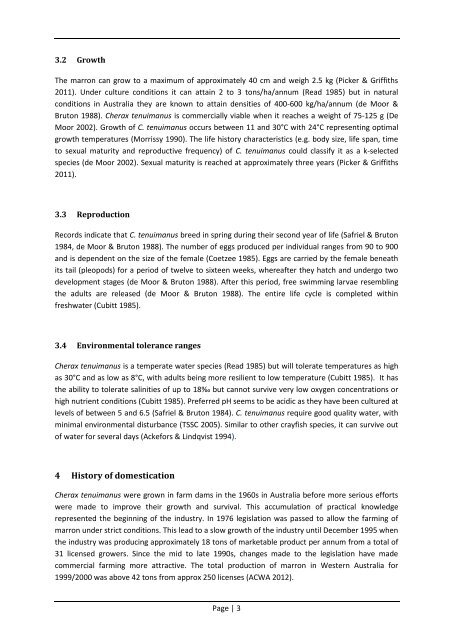Marron, freshwater crayfish Cherax tenuimanus - Department of ...
Marron, freshwater crayfish Cherax tenuimanus - Department of ...
Marron, freshwater crayfish Cherax tenuimanus - Department of ...
You also want an ePaper? Increase the reach of your titles
YUMPU automatically turns print PDFs into web optimized ePapers that Google loves.
3.2 Growth<br />
The marron can grow to a maximum <strong>of</strong> approximately 40 cm and weigh 2.5 kg (Picker & Griffiths<br />
2011). Under culture conditions it can attain 2 to 3 tons/ha/annum (Read 1985) but in natural<br />
conditions in Australia they are known to attain densities <strong>of</strong> 400-600 kg/ha/annum (de Moor &<br />
Bruton 1988). <strong>Cherax</strong> <strong>tenuimanus</strong> is commercially viable when it reaches a weight <strong>of</strong> 75-125 g (De<br />
Moor 2002). Growth <strong>of</strong> C. <strong>tenuimanus</strong> occurs between 11 and 30°C with 24°C representing optimal<br />
growth temperatures (Morrissy 1990). The life history characteristics (e.g. body size, life span, time<br />
to sexual maturity and reproductive frequency) <strong>of</strong> C. <strong>tenuimanus</strong> could classify it as a k-selected<br />
species (de Moor 2002). Sexual maturity is reached at approximately three years (Picker & Griffiths<br />
2011).<br />
3.3 Reproduction<br />
Records indicate that C. <strong>tenuimanus</strong> breed in spring during their second year <strong>of</strong> life (Safriel & Bruton<br />
1984, de Moor & Bruton 1988). The number <strong>of</strong> eggs produced per individual ranges from 90 to 900<br />
and is dependent on the size <strong>of</strong> the female (Coetzee 1985). Eggs are carried by the female beneath<br />
its tail (pleopods) for a period <strong>of</strong> twelve to sixteen weeks, whereafter they hatch and undergo two<br />
development stages (de Moor & Bruton 1988). After this period, free swimming larvae resembling<br />
the adults are released (de Moor & Bruton 1988). The entire life cycle is completed within<br />
<strong>freshwater</strong> (Cubitt 1985).<br />
3.4 Environmental tolerance ranges<br />
<strong>Cherax</strong> <strong>tenuimanus</strong> is a temperate water species (Read 1985) but will tolerate temperatures as high<br />
as 30°C and as low as 8°C, with adults being more resilient to low temperature (Cubitt 1985). It has<br />
the ability to tolerate salinities <strong>of</strong> up to 18‰ but cannot survive very low oxygen concentrations or<br />
high nutrient conditions (Cubitt 1985). Preferred pH seems to be acidic as they have been cultured at<br />
levels <strong>of</strong> between 5 and 6.5 (Safriel & Bruton 1984). C. <strong>tenuimanus</strong> require good quality water, with<br />
minimal environmental disturbance (TSSC 2005). Similar to other <strong>crayfish</strong> species, it can survive out<br />
<strong>of</strong> water for several days (Ackefors & Lindqvist 1994).<br />
4 History <strong>of</strong> domestication<br />
<strong>Cherax</strong> <strong>tenuimanus</strong> were grown in farm dams in the 1960s in Australia before more serious efforts<br />
were made to improve their growth and survival. This accumulation <strong>of</strong> practical knowledge<br />
represented the beginning <strong>of</strong> the industry. In 1976 legislation was passed to allow the farming <strong>of</strong><br />
marron under strict conditions. This lead to a slow growth <strong>of</strong> the industry until December 1995 when<br />
the industry was producing approximately 18 tons <strong>of</strong> marketable product per annum from a total <strong>of</strong><br />
31 licensed growers. Since the mid to late 1990s, changes made to the legislation have made<br />
commercial farming more attractive. The total production <strong>of</strong> marron in Western Australia for<br />
1999/2000 was above 42 tons from approx 250 licenses (ACWA 2012).<br />
Page | 3
















